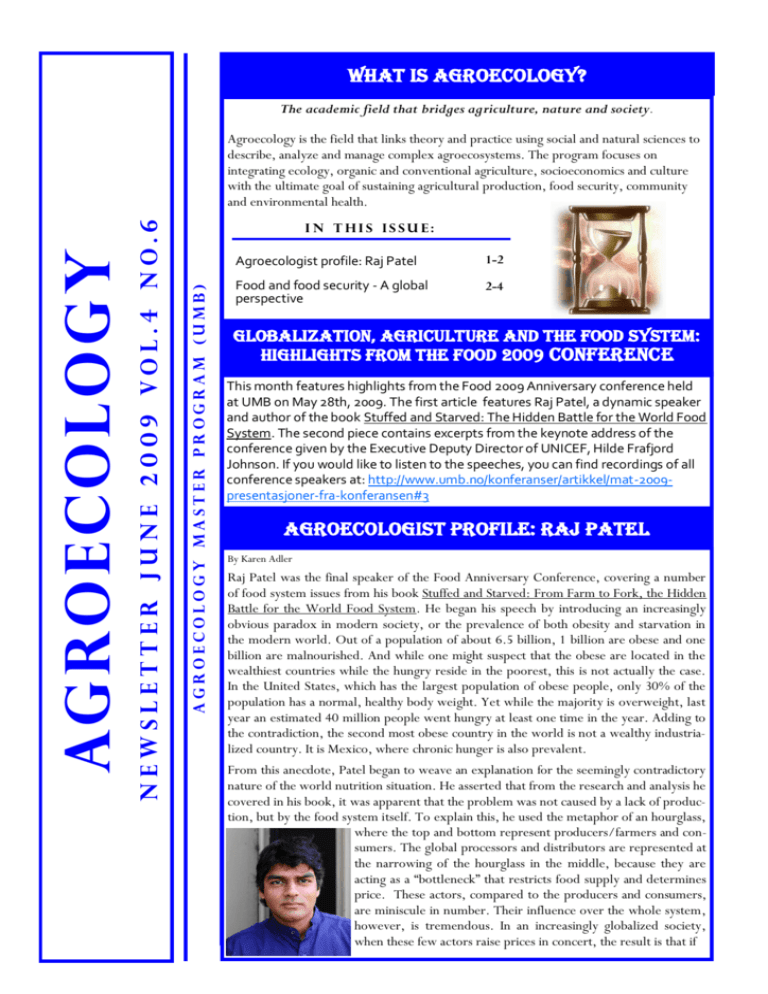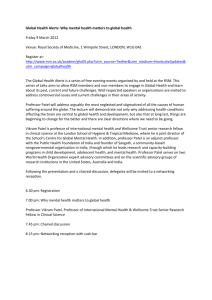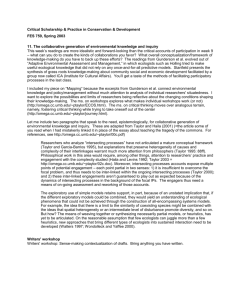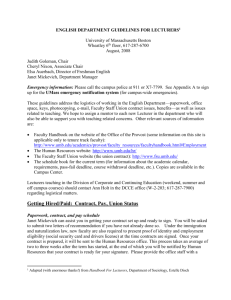A G R O E C O L O G Y
advertisement

WHAT IS AGROECOLOGY? The academic field that bridges agriculture, nature and society. In This issu e: Agroecology Master program (umb) N e w s l e t t e r J u n e 2 0 0 9 Vo l . 4 n o. 6 AG RO E C O LO G Y Agroecology is the field that links theory and practice using social and natural sciences to describe, analyze and manage complex agroecosystems. The program focuses on integrating ecology, organic and conventional agriculture, socioeconomics and culture with the ultimate goal of sustaining agricultural production, food security, community and environmental health. Agroecologist profile: Raj Patel 1-2 Food and food security - A global perspective 2-4 Globalization, agriculture and the food system: highlights from the food 2009 conference This month features highlights from the Food 2009 Anniversary conference held at UMB on May 28th, 2009. The first article features Raj Patel, a dynamic speaker and author of the book Stuffed and Starved: The Hidden Battle for the World Food System. The second piece contains excerpts from the keynote address of the conference given by the Executive Deputy Director of UNICEF, Hilde Frafjord Johnson. If you would like to listen to the speeches, you can find recordings of all conference speakers at: http://www.umb.no/konferanser/artikkel/mat-2009presentasjoner-fra-konferansen#3 Agroecologist Profile: Raj Patel By Karen Adler Raj Patel was the final speaker of the Food Anniversary Conference, covering a number of food system issues from his book Stuffed and Starved: From Farm to Fork, the Hidden Battle for the World Food System. He began his speech by introducing an increasingly obvious paradox in modern society, or the prevalence of both obesity and starvation in the modern world. Out of a population of about 6.5 billion, 1 billion are obese and one billion are malnourished. And while one might suspect that the obese are located in the wealthiest countries while the hungry reside in the poorest, this is not actually the case. In the United States, which has the largest population of obese people, only 30% of the population has a normal, healthy body weight. Yet while the majority is overweight, last year an estimated 40 million people went hungry at least one time in the year. Adding to the contradiction, the second most obese country in the world is not a wealthy industrialized country. It is Mexico, where chronic hunger is also prevalent. From this anecdote, Patel began to weave an explanation for the seemingly contradictory nature of the world nutrition situation. He asserted that from the research and analysis he covered in his book, it was apparent that the problem was not caused by a lack of production, but by the food system itself. To explain this, he used the metaphor of an hourglass, where the top and bottom represent producers/farmers and consumers. The global processors and distributors are represented at the narrowing of the hourglass in the middle, because they are acting as a ―bottleneck‖ that restricts food supply and determines price. These actors, compared to the producers and consumers, are miniscule in number. Their influence over the whole system, however, is tremendous. In an increasingly globalized society, when these few actors raise prices in concert, the result is that if one has money she can eat, but if she is poor she will starve. In other words, famine is not caused by a lack of food, but by the poverty of the consumers who cannot afford to buy it. This was exemplified when the prices of staple foods like rice, wheat and maize doubled and tripled as they did in the past year, resulting in hunger and the subsequent food riots. Agroecology Master program umb Patel blamed the paradox on the economic policies that underlie the global food system; structural adjustments and economic liberalization advocated by the World Bank (which he once worked for) and wealthy corporations are causing vast inequalities between rich and poor, which equates to the problem of obesity and hunger. These organizations argue that a free market will provide price signals that lead farmers to grow what is most profitable for globalized trade, yet what often happens is that farmers read the signals too well. If grain crops don’t yield a high profit, then farmers stop growing them, but if the price of these same commodities increase dramatically like it did last year, the result is famine. Norwegian University of Life Sciences (UMB) Tel: +47 64 96 50 00 Other: +47 64 96 56 44 Fax: +47 64 96 50 01 E-mail: postmottak@umb.no The Student Information Center Phone: +47 64 96 61 00 Email: opptak@umb.no/studie www.umb.no/studie Nordic School of Agroecology/Ecological Agriculture Phone: +47 64 96 56 44 Email: geir.lieblein@umb.no www.agroasis.org Editors Karen Adler and Charles Francis karen.adler@umb.no charles.francis@umb.no Agroecology Master program (umb) P.O Box 5003 N-1432 Ås Norway In response, Patel advocated for the realization of a new paradigm based on food sovereignty, which emphasizes the placement of power over the process through which food is produced, processed, distributed, supplied and consumed into the hands of all of the actors of the food system. In this sense, it goes beyond the right to food that is a principle of food security by assuming that nations and citizens have the liberty to shape food policy democratically. Essentially, Patel argued that the realization of greater global food sovereignty is a necessary precondition for dealing with the stuffed and starved paradox. Raj Patel is a researcher at the University of KwaZulu-Natal in South Africa and a visiting scholar at UC Berkeley. If you are interested in reading more about food sovereignty and alternative suggestions for feeding an increasing global population, Patel recommends these two websites: viacampesina.org and agassessment.org. Food and food security - A Global Perspective Exerpts of the Keynote address From the food anniversary conference Given by Hilde Frafjord Johnson; adapted by Karen Adler Today we stand at a crossroads. The combined impact of the food and financial crises is unprecedented. It threatens the livelihoods of millions of poor people and jeopardizes future progress for billions. Only a global collective effort can change this situation and set a new course. There are now one billion hungry people in the world. Of the nearly 6.7 billion people on the planet, about 2 billion are food insecure. They cannot afford a healthy diet, limiting use of their full physical and intellectual capacity. And the hungry are poor. Even before the food and the financial crises hit, 160 million people in the world lived in ultra poverty on less than 50 cents a day. According to FAO, the number of undernourished people in the world has now risen to more than 960 million, a significant increase from 2007. And the numbers will increase to one billion in this year 1. As a result of the soaring food and fuel prices between 3 and 4 times more people were pushed into poverty last year. For those already struggling to get their daily food, the double shock of food and fuel price inflation affected their basic survival. Over the last 6-9 months we have seen a deterioration in acute malnutrition in Afghanistan, Niger, Sierra Leone and Uganda, and with high acute malnutrition rates among the urban poor of Cambodia, CongoBrazzaville, Kenya and Tanzania. This year, another 2 to 3 times as many are expected to become extreme poor2. The sharp increase in food prices from 2007 and mid-2008 had serious implications for food and nutrition security, macro-economic stability, and political security. And it is not over. After steep declines at the end of 2008, prices have been gradually edging up again during the first quarter of this year. Maize prices today are 50% Food and food security - A Global Perspective higher than the average price prevailing between 2003 and 2006, while rice prices are 100% higher 3. According to International Food Policy Research Institute (IFPRI), the current recession and the corresponding reduced investment in the global economy will lead to an increase in agricultural prices in the medium term, along with the number of hungry people. This is the context of today’s conference on Food – and for the 150 year anniversary of this university, the Norwegian University of Life Sciences. Ag roe c ol o g y M a s te r p ro g r a m ( u m b ) Why did this happen? Why a Food Crisis and why now? Agriculture reached global headlines for the first time in decades last year. Never before had CNN reported repeatedly on food supplies and food prices. We witnessed riots in West Africa, change in government in Haiti, violent protests in Mexico and Pakistan – all sparked by rocketing food prices. When we look back, the factors playing a role in the crisis varied in nature - some cyclical and some structural: due to population growth, billions of people were buying ever-greater quantities of food. In some countries, many had stopped growing their own food and now had the cash to buy a lot more of it. Global stockpiles of some basics had dwindled to their lowest point in decades. Rice — a staple for billions of Asians —soared to its highest price in 20 years, while supplies were at their lowest level since the early 1980s 4. Meanwhile, in early 2008, the global supply of wheat was lower than it had been in about 50 years — just five weeks' worth of world consumption was on hand 5. The spike in oil prices, which hit a record level of almost $150 per barrel in July 2008, pushed up fertilizer prices, as well as the cost of trucking food from farms to local markets and shipping it abroad. Climate change has also been a key factor. Harvests had been seriously disrupted by freak weather, including prolonged droughts in Australia and southern Africa, floods in West Africa, and this past winter's deep frost in China and record-breaking warmth in northern Europe. The push to produce biofuels as an alternative to hydrocarbons further strained food supplies, especially in the U.S., where generous subsidies for ethanol had lured thousands of farmers away from growing crops for food. This put additional pressure on the market. In any crisis, there is speculation which further pushes price rises. There is no doubt that this happened here. In Dhaka, Bangladesh, for example, soybean oil alone shot up 60% in a year. However, these short term causes would not have had the same dramatic effect on world markets if we had not experienced a 5‐10 year period of imbalance, in which the growth in demand outpaced the growth in cereal production. This imbalance has been reflected in declining global cereal stocks since 2000. Cereal demand has been growing every year, due to rising incomes in China, India, and, more recently, Sub‐Saharan Africa. As incomes rise, people diversify their diet. Consumption of more meat and other animal products increase the demand for feed, particularly maize. Meanwhile, declining public investment in agricultural research further fueled the declining agricultural yield. Ad hoc market- and trade policies such as export bans and import subsidies added further volatility to the international food market. A World Bank recent report said many countries, including 17 of the G20 members, implemented a total of 47 measures that restrict trade. There are also distribution issues. It is difficult to get food from surplus countries worldwide to food deficit countries, and in the midst of the food crisis many countries started to take defensive measures. More of such protectionism could worsen the situation for developing nations in the face of the severe economic downturn. The financial crisis has also added to the problems as global credit strains have dried up trade financing, hampering countries' ability to trade. Demand for agricultural commodities for food, feed, and fuel is likely to continue to escalate with increasing population numbers once economic growth is picking up again. In other words, these problems will remain with us in the long term. Hilde Frafjord Johnson goes on to discuss the lack of investment in agriculture and food production, the impact of food insecurity on nutrition, the issue of human rights and food, the key policy failures that led to global hunger and three key actions that should be taken to improve food security for all. These include investing in agricultural development at global, national, and smallholding farmer levels, ensuring coherence in policies related to food markets, global trade and climate change, and focusing on nutrition security and targeted support to the poorest. Finally, the speech ends with the speaker addressing the importance of knowledge and research to face the challenge of food security: Food and food security - A Global Perspective Ag roe c ol o g y M a s te r p ro g r a m ( u m b ) And this brings me to this University and the need for knowledge and research as we face these global challenges. So much of what we know is due to the systematic research carried out by academic centers and development institutions around the world. Their role in producing evidence and continually challenging practices and responses is critical in ensuring that policies and actions achieve results. Yet, total development aid to agricultural research fell by almost 65 % between 1980 and 2003. This must change. We are now faced with incredible challenges. Among the most critical ones affecting food availability will be the demographic boom and climate change. By 2050, the world’s population will stabilize at about 9 billion. Due to increasing consumption in developing countries, the equivalent of 12 billion people will be placing demands on the global food system, compared to today’s consumption rates. A more urbanized population with higher consumption will contribute to this. In other words – there is a likelihood of a dramatic increase in demand. At the same time, we know that climate change will put significant stress on the natural resource base, with global warming affecting both water availability and weather volatility. This again, will impact on food supplies. This will have dramatic consequences. Faced with these challenges, research is essential. We need research in life sciences and agriculture both in developing crops that can provide larger yields and are more resilient to changing weather patterns. We need research to help us develop better climate information and forecasting, better conservation techniques and better methods to reduce land erosion and degradation. We need research in fisheries and fish farming that will benefit developing countries and poor families. Given currently available technologies, current consumption patterns, and the negative effects of climate change, we know that food security for all cannot be achieved. In this context, many people are calling for a new green revolution, pointing to biotechnology and genetically modified crops. It is clear that we need to utilize new technologies to be able to cater to the increasing demand in food. UNICEF has no position on GMO in agriculture. Nevertheless, there is reason to caution against believing in quick fixes or miracle solutions in this area. We also need to be aware of the potential environmental impacts of the use of genetically modified crops – and in particular in developing countries with their limited capacity to manage risk and potential impacts of genetic pollution. There is no quick fix in this area also because food production and delivery is complex, depending on inputs, knowledge, infrastructure, proximity to markets, and national and global policies. It also depends on human resources – retaining a rural work force. A comprehensive approach is needed. That is why we also need much more applied research and analysis to help us make the right policy decisions. We need more knowledge to provide the right incentives for farmers in the poor countries to achieve higher growth in agricultural production and fishing. We need research and analyses that can build on lessons learned and best practices and identify better policies in utilizing agricultural potential, opportunities in fisheries, and translating food production into food for a growing hungry population. More research and analysis is also required to help us understand how to overcome challenges of infrastructure, transport and international standards in global markets. We need to invest more in research and knowledge in all these areas in developing countries, as it is among the poorest that the challenges will be the greatest. And it is in the developing world where the impact of continued failed policies will be most dramatic. That is why the work conducted at this university is so important, be it at NORAGRIC or the core departments of the university. That is also why the partnerships with research institutions in the developing world are so critical. And that is why the programs offered to students from developing countries are so essential. Your foreign students are future leaders in the agricultural field in their home countries. You should be proud of what you have achieved during the last 150 years. And – your competence and knowledge is more needed than ever. You can read Hilde Frafjord Johnson’s speech in its entirety at http://www.umb.no/statisk/konferanser/hfj_food_280509.pdf 1 According to the CEB Communiqué of 5 April 2009. 2 Those living below the international poverty line of $1.25 a day in 2005 purchasing power parity terms 3 World Bank 2009 4 According to the U.S. Department of Agriculture 5 According to the U.N. Food and Agricultural Organization





